

The recent megafire around Fort McMurray drew worldwide attention. Not only did this fire devastate a community, the fire also grew exceptionally large and started very early in the fire season. Northern forests are rapidly changing, and fire plays a crucial role in this transition.

A recently burned forest in Saskatchewan, Canada. (Credit: Sander Veraverbeke)
Fires in the boreal forest emit large amounts of carbon dioxide, the most important greenhouse gas. Exactly how much they emit is a difficult question to answer. Over many decades these forest have piled up thick layers of downed needles and other organic material, resulting in thick carbon-rich soils. When a fire spreads through the forest, the carbon it emits comes mostly from these soil layers, and not so much from the actual live trees.
The real question is: how deep do these fires burn into the soils? There is a lot a variability depending on which forest type is burning and how hot it burns.
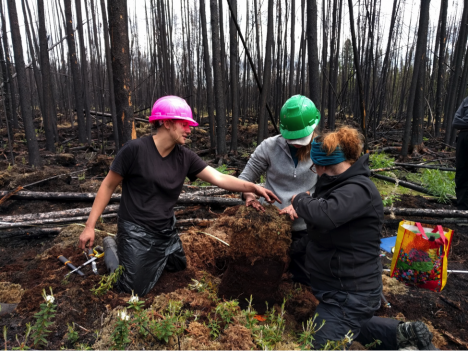
Some members of our team just excavated a deep organic soil. They will carefully measure this soil pie and cut out some samples for lab analysis. (Credit: Veraverbeke)
As part of the ABoVE field campaign, our field crew flew into Saskatoon, Saskatchewan on May 28th from Massachusetts, California, Ontario, and the Netherlands. We joined up with another field team from the University of Saskatchewan. After stocking up on supplies, we drove about four hours north to enter vast swaths of boreal forest.
Our goal in Saskatchewan is to quantify how much carbon fires emit in forest types that currently burn infrequently, but may become more sensitive to fire in the near future. For example, we are interested in reburns in forests that last burned only a couple of years ago, or burns in forests where people previously cut down trees. With all the changes that are underway it is important to understand how fires impact these forest types and how much carbon they emit.

Our maneuvers in challenging terrain are rewarded by gorgeous vistas of landscapes that are untouched – except by fire. (Credit: Veraverbeke)
Since we arrived, we have been hitting up quite a few field plots. Getting to these field plots requires off-trail hiking in often-rough terrain, with soggy bogs and steep rocky hills. We have to scramble through piles of wood that fell down after the fire. Once we get to our desired site, we measure for several hours. We take samples of soils that will be analyzed in the lab and measure lots of trees (as many as several hundred). By doing so, we are able to assess the amount carbon of that was emitted by the fire.
We can link up our field measurements with data from NASA satellites to better characterize all fires within Canada and Alaska. During the day we get rewarded for our hard work with lunches-with-views, mosquitoes, and some thunderstorms that hopefully rain out somewhere far on the horizon…
Sander Veraverbeke is a project scientist at the University of California, Irvine, and an assistant professor in Remote Sensing at Vrije Universiteit in Amsterdam
Brian and Ruthie here!
Natalie and Willem packed up their bags and flew the coop over the weekend. It was sad to see them go, but we’ve been here until we could find the rest of our space robins. And now we are proud to introduce our final eight space robins!
Robins in the rain
Even though it’s late April and probably feels a lot like spring wherever you are, we woke up to cold wintry mornings the past few days. You might think that rain would dampen our spirits, but we were excited to open our nets because we were hoping the robins wouldn’t want to travel in the rain and wind. Birds can stay warm even in a cold rain because their feathers keep the water off their skin.
As it turns out, a flock settled on our lawn to look for worms! And that’s how we met Birdie Sanders, Twitter, and Skyler. After they were suited up, they flew right back to join their friends!
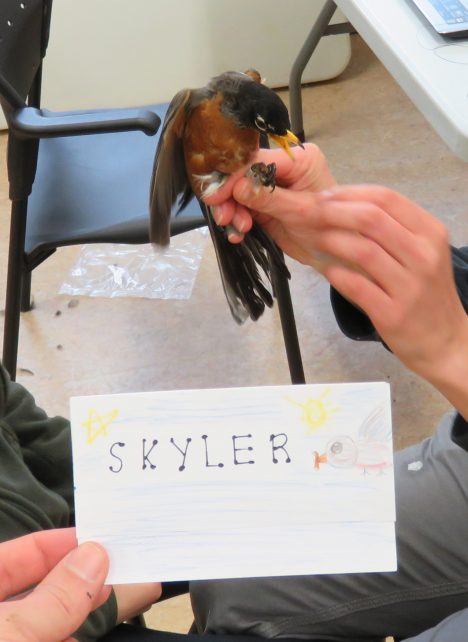
Skyler is an adult male. His name was chosen by Mr. Lane’s 5th grade class. (photo credit: Ruthie Oliver)

Twitter is an adult female. Her name was chosen by Mrs. Wagner’s 4th grade class. (photo credit: Ruthie Oliver)
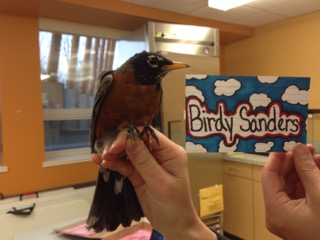
Birdy Sanders is an adult male. His name was chosen by Mr. Tan’s 5th grade class. (photo credit: Ruthie Oliver)
Tuesday the sun finally broke through the clouds! The warm lawn must have looked like a great place to stop for lunch because we ended up finding our final four space robins out there.
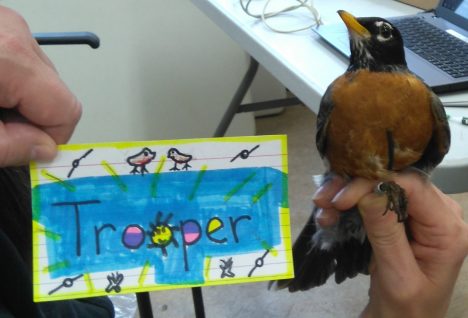
Trooper is an adult male. His name was chosen by Mrs. Caunitz and Mrs. Barsanti’s 4th grade class. (Photo credit: Nicole Krikun)

Flappy is an adult female. Her name was chosen by Ms. Murphy and Mrs. Nadler’s 4th grade class. (Photo credit: Nicole Krikun)
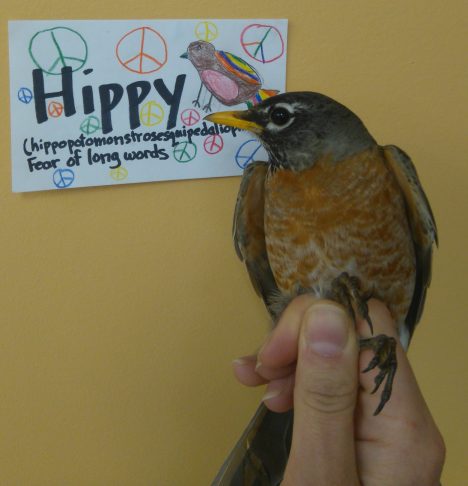
Hippy is an adult female. Her name was chosen by Ms. O’brien’s 5th grade class. (Photo credit: Nicole Krikun)
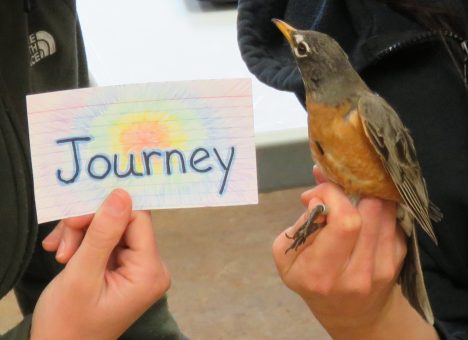
Journey is an adult female. Her name was chosen by Mrs. Sutton’s 4th grade class. (Photo credit: Brian Weeks)
And… our final space robin is Sky!

Sky is an adult female. Her name was chosen by Mrs. McFadden and Mrs. Viola’s 4th grade class. (Photo credit: Brian Weeks)
We’ve certainly made a lot of new robin friends on this trip, but robins aren’t the only species migrating through the area. Some of our favorites are a Sharp-shinned Hawk (check out those red eyes!), Fox Sparrow, and Yellow-bellied Sapsucker! Sharp-shinned Hawks don’t just look fierce, they are real predators. They eat lots of smaller birds, including robins – eek! You can learn more about them here: https://www.allaboutbirds.org/guide/Sharp-shinned_Hawk/id, https://www.allaboutbirds.org/guide/Fox_Sparrow/id.
We now have 17 space robins flying for us!
Thanks for all your help along the way!
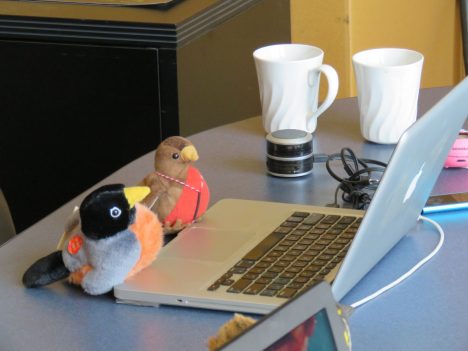
P.S. Chirpie has made a new friend up here at the Boreal Centre. Hope you’ve enjoyed reading the blog as much as they have! (Photo credit: Brian Weeks)
The newest space robins
At 6:40 am five American robins flew into our nets. What a great start to the day!
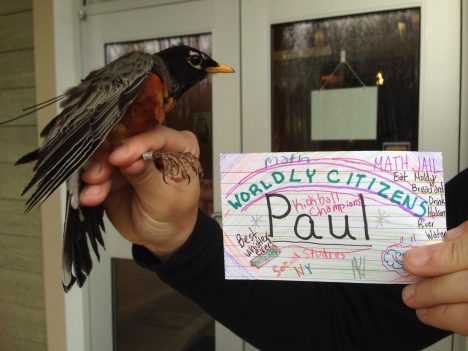
Paul is an adult male. His name was chosen by Mrs. Arietta’s 5th grade class. (Photo credit: Natalie Boelman)
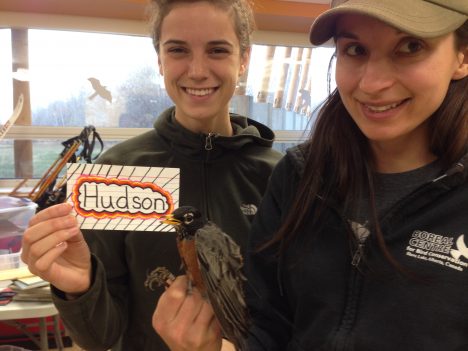
Hudson is an adult male. His name was chosen by Mr. Wasser’s 4th grade class. (Photo credit: Natalie Boelman)
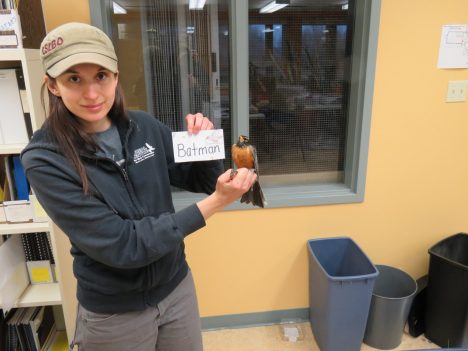
Batman is an an adult male. His name was chosen by Mrs. Heilbronn’s 5th grade class. (Photo credit: Brian Weeks.)
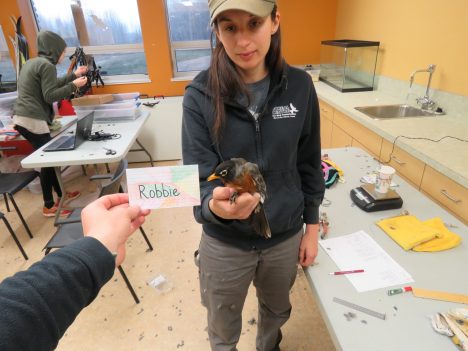
Robbie is an adult male. His name was chosen by Mr. McAuliffe’s and Mrs. Cavanaugh’s 5th grade class. (Photo credit: Brian Weeks.)
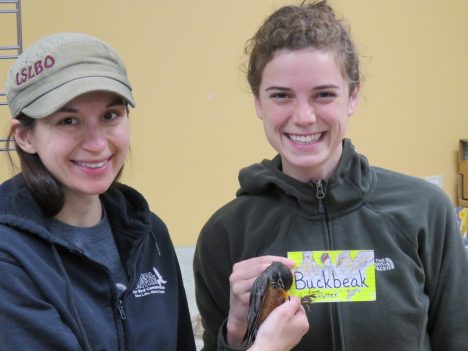
Buckbeak is a young male. His name was chosen by Mr. Krump’s 5th grade class. (Photo credit: Brian Weeks.)
Other bird species we’ve seen so far
While we’re on the lookout for American robins, we see lots of other bird species. Brian’s been taking some pretty spectacular photos of them, so we thought we’d share them with you.
Busy as a beaver!
The other evening we decided to go check out one of the many nearby beaver lodge and dam complexes. We are in Canada after all!
Have you ever heard the expression “He/She is as busy as a beaver”? It comes from the fact that beavers are famous for keeping themselves very busy gnawing away at the trunks of trees until they fall to the ground – timber! – and can be used to build their homes (lodges) and dams to create lakes where there were previously small streams. You can learn all about beavers here and the structures they build here:
http://animals.nationalgeographic.com/animals/mammals/beaver/.
Although I had heard a lot about how busy beavers are, I had never seen it with my own eyes and wow, was I impressed! Seeing first hand all the work these beavers have done made me feel awfully lazy. Take a look for yourself:
That’s all we have for today, but tune in again soon to meet the next batch of space robins!
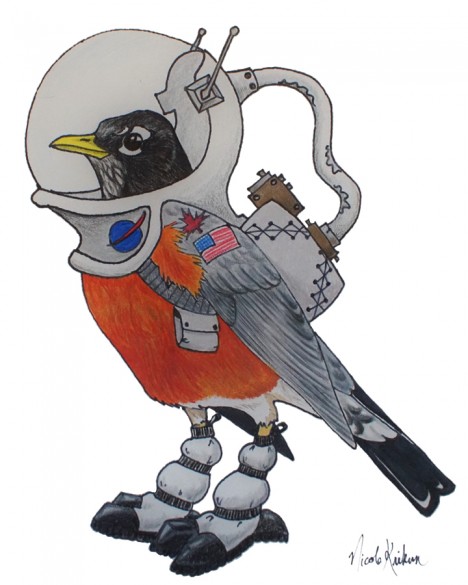
Space robin by Nicole Krikun.
This morning we woke up to a lot more bird songs in the forest compared to what we’d been hearing in the days before. We were pretty excited. We waited and watched for any of them to fly into our nets.
In this video, you can’t really see that there are lots of birds around, but you sure can hear them! At the end of the movie, you’ll also see Brian and Nicole coming out of the woods where we have some nets up. See those cloth bags they are carrying? Each one has a robin in it! The bags are used to transport the birds safely to the location where we work with them. Our nets caught five birds this morning, all at once. We really hit the jackpot!
Meet our four new space robins: Zee, Big Mac, Pepperoni and Billie Jo
We’ve got four more space robins to introduce you to today! You may be wondering why there are only four birds to introduce you to today, even though we actually caught five.
It’s because not all of the birds we caught were big enough to carry the mini-GPS tags, so we had to let them go after weighing them. Here are photos of the four new space robins:

Zee is an adult male. His name was chosen by Mrs. Fluger’s 4th grade class. That’s my daughter Aline’s class! (Credit: Natalie Boelman)

Pepperoni is an adult female – our first female! Her name was chosen by Mrs. Rudin’s 4th grade class. (Credit: Ruthie Oliver)

Big Mac is a 1 year old (juvenile) male. His name was chosen by Mrs. Christie-Blick’s 5th grade class. (Credit: Willem Boelman)
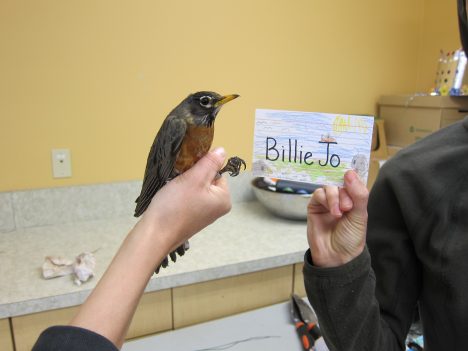
Billie Jo is an adult male. His name was chosen by Mrs. Early’s 5th grade class.
Suiting up a space robin
This movie shows Nicole and Brian suiting up one of our new space robins with a harness and mini-GPS. You can see the bird is relatively calm and cooperative.
Movie credit: Natalie Boelman
Releasing a space robin back into the wild
This movie shows Brian releasing one of our space robins back into the wild. Nicole showed us that if you put a bird on it’s back, it stays very still because it has no experience being on its back in the wild – it just doesn’t know what to do on it’s back, so it does nothing. The movie shows Brian giving this technique a shot – pretty neat!
Movie credit: Willem Boelman
How to hold a little bird
This last movie is of Nicole showing us how to hold a little bird. She does the demonstration with a cute little Black-capped Chickadee, not a robin. You can read about Black-capped Chickadees here: https://www.allaboutbirds.org/guide/Black-capped_Chickadee/id. Nicole shows us two different ‘grips’ (or holds) that keep the bird safe while it is being examined: ‘Bander’s grip’ or ‘Photographer’s grip’.
Movie credit: Natalie Boelman
More space robins are on their way!
Well, that’s all we have to report today, but we think that a whole lot more robins will be showing up in Slave Lake very soon. That’s because Nicole has a friend living in the city of Edmonton (which is located about 250 km south of Slave Lake) who told her yesterday that there are tons of robins in Edmonton all of sudden. As the birds make their way north from Edmonton, some of them will likely stop in Slave Lake to eat and rest. So stay tuned!
Our adventure began in Vancouver, British Columbia, Canada on Wednesday, April 13th. After a solid day of driving up and over the Rocky Mountains, we arrived in Alberta on Thursday. Here are some photos from the drive. You can see our team mascot in the photos – a stuffed animal version of an American robin. His name is Chirpy, and we brought him along because Mrs. Christie-Blick’s 5th grade class at Cottage Lane Elementary asked us to. You can see that the kids even outfitted Chirpy with a pretend GPS unit and string harness.
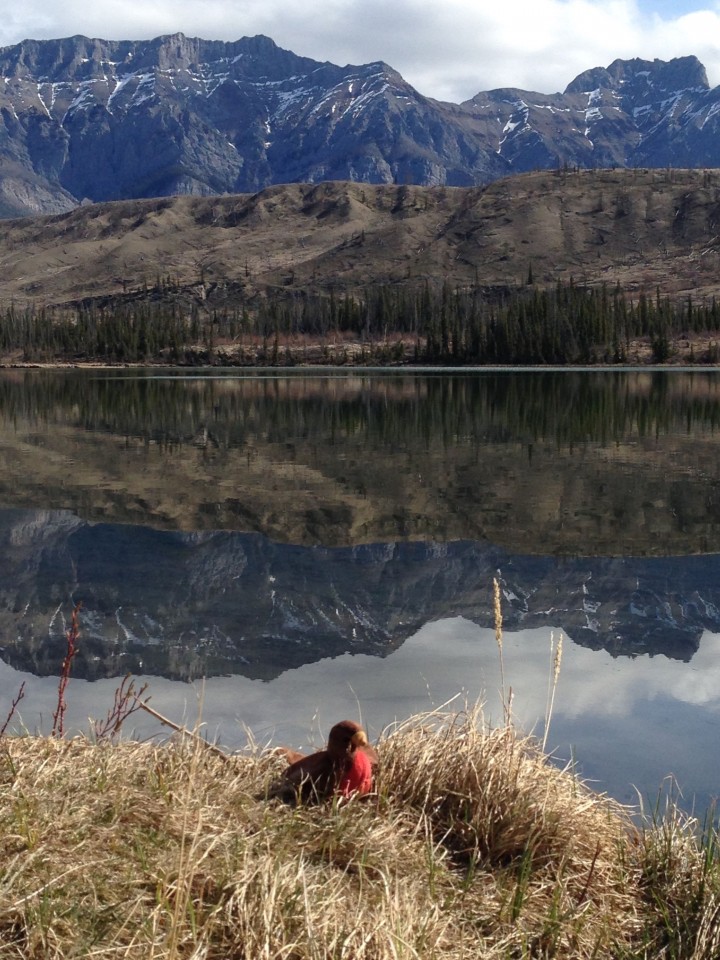
Chirpy taking a rest on the shores of a lake near Jasper, AB. Photo credit: Natalie Boelman.
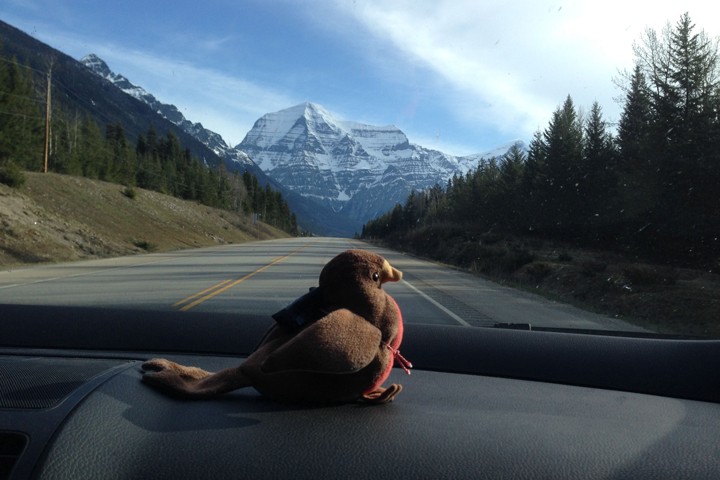
Chirpy in the car with Mt. Robson, British Columbia, Canada in the background. Photo credit: Natalie Boelman.
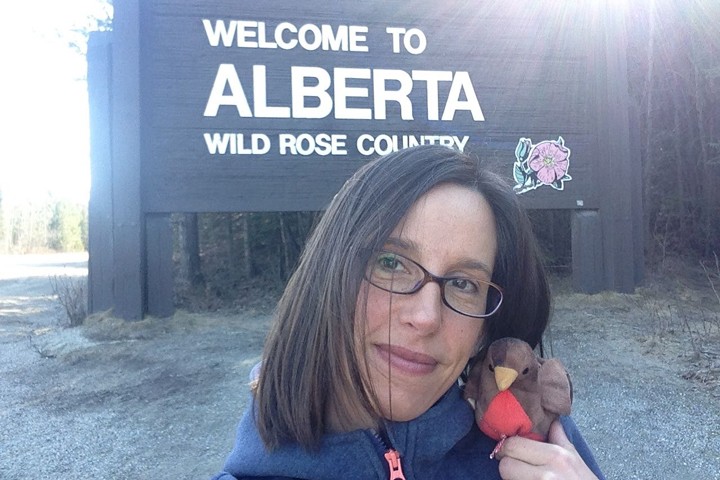
As Chirpy and I were posing in front of the Welcome to Alberta sign, some people in a car stopped and said they thought he was a real bird! Photo credit: Natalie Boelman.
Check out our field site & meet our team!
On Thursday evening around 8:30 pm, we arrived at our field site in the boreal forest, where we will catch and tag 30 American robins over the next week to ten days. We are working and collaborating with scientists at the Lesser Slave Lake Bird Observatory (LSLBO) and the Boreal Centre for Bird Conservation, which are located just north of the town of Slave Lake, Alberta.
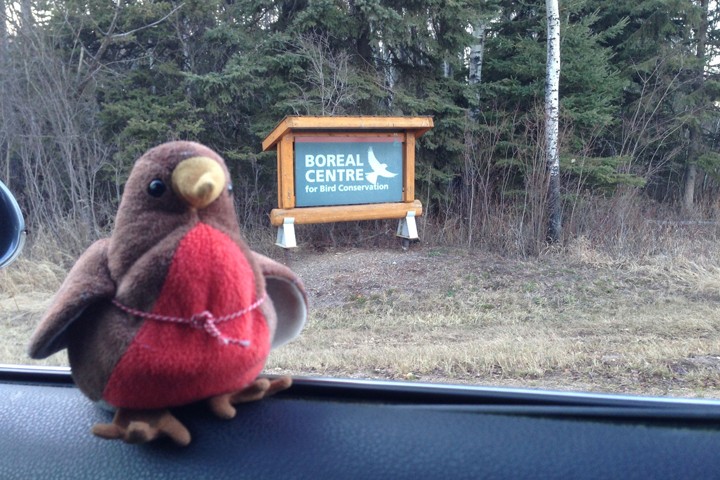
Chirpy arriving at the Boreal Center for Bird Conservation (BCBC).
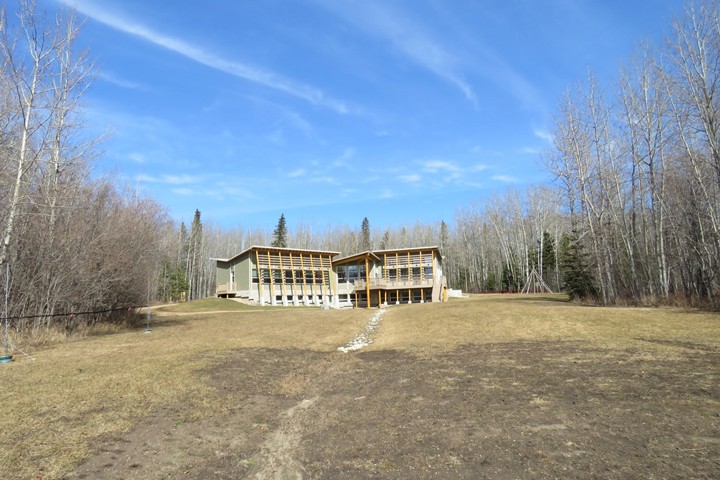
The Boreal Center for Bird Conservation (BCBC).
And, here’s a photo of our team. My Dad and I are on the far left. Willem is my super-handy Dad who has come along for the adventure and to help us with whatever we need help with – thanks Dad! Next to me are Ruthie and Brian, who are both graduate students at Columbia University in New York. Ruthie is working towards her PhD in Earth and Environmental Sciences at the Lamont-Doherty Earth Observatory, and Brian is working towards his PhD in Ecology, Evolution and Environmental Biology. Nicole – our resident bird banding expert – is on the far right. Nicole is a bird biologist who has been working at the LSLBO for almost ten years. She knows a whole lot about the birds here, and how best to catch them!
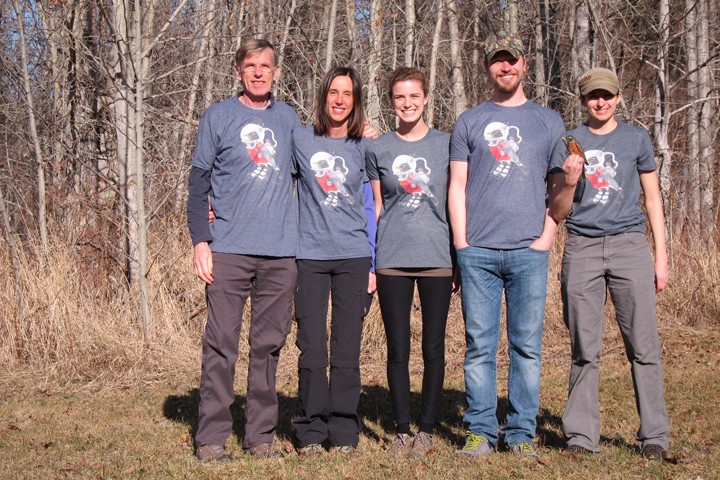
Check out our team T-shirts! Nicole drew this ‘space robin’ and we all liked him so much that we got some fun t-shirts made with him on it. If you looked through the set of slides I posted on the first blog post, you might be able to guess why Nicole drew the robin wearing a NASA astronaut’s space suit. Any guesses?
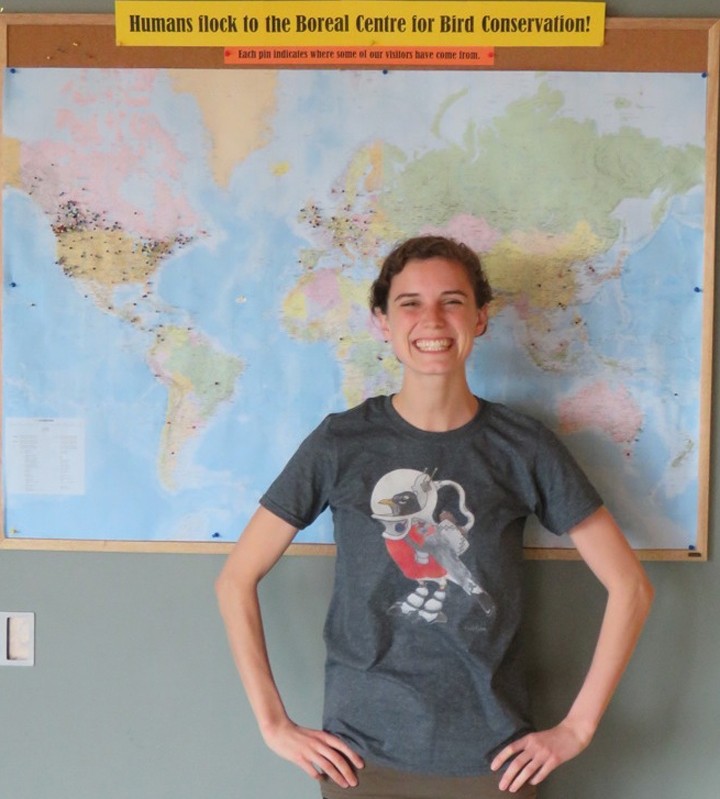
Ruthie modeling our Space Robin t-shirts.
If you haven’t already figured it out, the robin is wearing a space suit because we are using information collected from satellites in outer space that are looking down at the Earth with special sets of ‘eyes‘ that we call sensors. From these satellite sensors, we will learn about two main things:
First, some of the satellites – the GPS satellites – tell us exactly where the robins are as they are migrating. We’ll call these the ‘bird location satellites’. You can learn more about them here.
Second, other satellites tell us about the habitats the robins are using or avoiding as they migrate – like, if there is still snow on the ground, or if they are spending time in a forest or a grassland, if the plants around them are very dry or sitting in big puddles of water, or if there is a forest fire burning. We’ll call these the ‘bird habitat satellites’. You can learn more about them here.
In addition, a third set of satellites will actually be used to transfer the information on where the birds are, from the bird, to me and my team once we’re back in New York. We’ll call these the ‘information transfer satellites’. You can learn more about them here.
Who knew that robins and satellites could work so well together?!
How to catch a robin
The first thing we did after getting a good night’s sleep was to make a plan for how to catch 30 American robins. I’d assumed that we’d be using the ‘playback technique’ where you play recordings of singing robins on one side of a mist net in the hopes that a curious bird hanging out on the other side of the net will fly into as she or he flies over to check out whose singing in their territory. I was familiar with this technique from my work on another project in Alaska, but Nicole had another idea that she thinks will work better to catch the robins migrating through our field site.
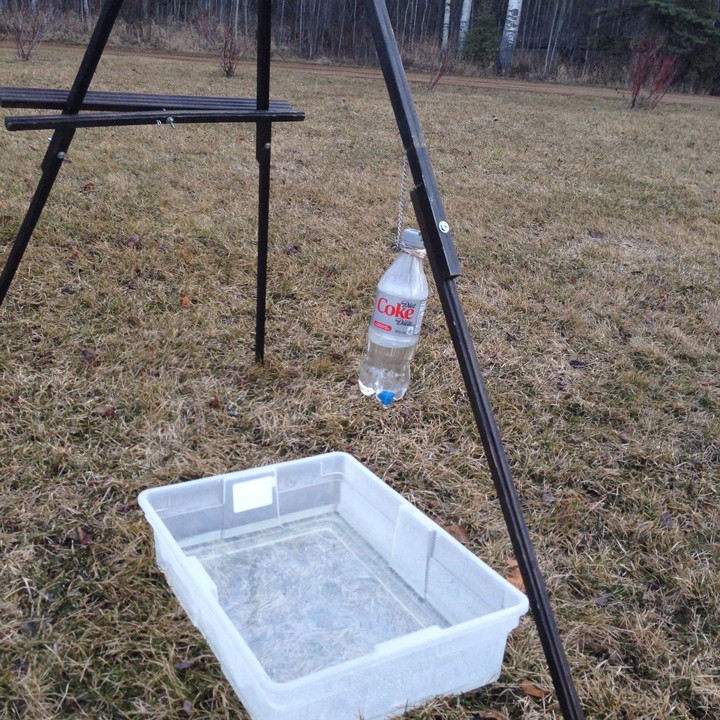
Bird bath with drip to attract migrating robins who are typically thirsty and looking for a place to bathe.
Nicole told us that the birds will be attracted to a bird bath because migrating robins are both thirsty and like to keep clean by bathing, but there’s not a lot of water available to the birds at this time of year because the nearby lake is still frozen and it hasn’t rained enough to create many puddles. So we filled up a big plastic box with water (this is the bird bath), and put it in a nearby field. Then, we got an empty soda bottle, cut a little tiny hole in the bottom, and stuffed a small piece of blue sponge in it. Next we filled up the soda bottle with water and hung it upside down over the bath, so that drops of water would fall from the sponge – kind of like a shower. When the drops of water from the bottle hit the bath water, they make a ‘drip drip drip’ sound that Nicole thinks will attract thirsty robins! We also put up four mist nets in a box shape around the bird bath so that any potential bathers would fly into a net on their way to/from the bath. Genius! Here is a photo of the bird bath and net setup.
While we waited for robins to notice the bird bath and hopefully get stuck in our nets, we went inside to get ready for the first bird that we hoped to catch. Ruthie and I worked on testing the mini-GPS tags (made by Lotek wireless), making sure they were fully charged, and programming them to work once they’re attached to a bird. Brian and Nicole worked on making the harnesses that the mini-GPS tags will be attached to, and my Dad went on a hunt for more harness material.
Not much time went by before our first American robin flew into a net, although it wasn’t one of the bird bath nets, it was a net that the LSLBO’s Bander in Charge (Richard Krikun) had set up about 2 km away for his own study. Thanks for sharing Richard!
Meet our first space robin: Trail Blazer
Meet ‘Trail Blazer’ – our first volunteer space robin! Isn’t he cute?

Ruthie showing her excitement over catching our first space robin, who we named Trail Blazer. Photo credit: Natalie Boelman.
Here is a video and a picture that show how Trail Blazer was caught, how he was weighed, and then equipped with a harness and mini-GPS tag.
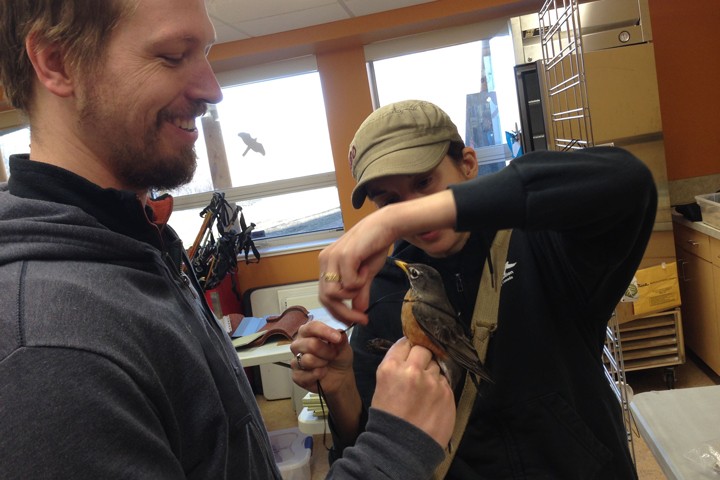
Nicole and Brian are suiting up Trail Blazer with a mini-GPS unit and harness. Photo credit: Natalie Boelman.
Once we were sure the harness and tag were secure and not bothering him, we took Trail Blazer outside and released him. He seemed to fly just fine with his new gear on, and perched for a while in a tree to do some feather rearranging. We hung out near him for about an hour to make sure that he was okay. Eventually he flew off confidently, presumably continuing his migration northwards.

Trail Blazer perching on a branch, showing off his GPS unit and harness. Shortly after this photo was taken, he flew off, presumably continuing his migration northwards. Photo credit: Brian Weeks.
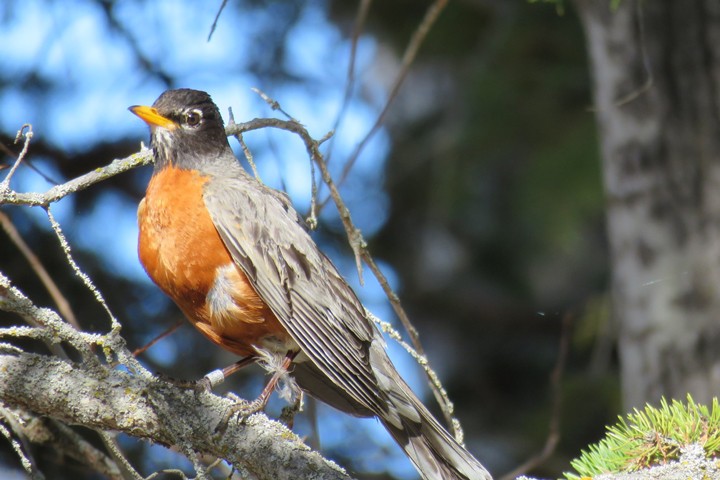
Another view of Trail Blazer. You can barely tell he is wearing his harness and mini-GPS unit. The little white band on his right ankle has a number on it that will help bird biologists recognize him in the future. Photo credit: Brian Weeks.
Safe travels Trail Blazer!
Where is Trail Blazer migrating to and where will he start his family?
We won’t know the answer to these questions for another two months from now because the mini-GPS tag that Trail Blazer is wearing will only send information on where he’s been to the ‘information transfer satellites’ once, in mid-June. Not only did we program his mini-GPS tag to collect information on where he decides to start his family, but also to collect information on the migration route he’ll take to get there! We programmed Trail Blazer’s tag to record his location every two days from the day we caught him (today) until about June 15 when his mini-GPS tag will likely run out of battery power. It’s a long time to be patient and wait to find out where he goes. While we’re waiting, we’ve got 29 more American robins to catch and outfit with tags, so we’ll have plenty to do to keep us distracted for a little while.
Check back here in a few days for more pictures, videos and space robin introductions!
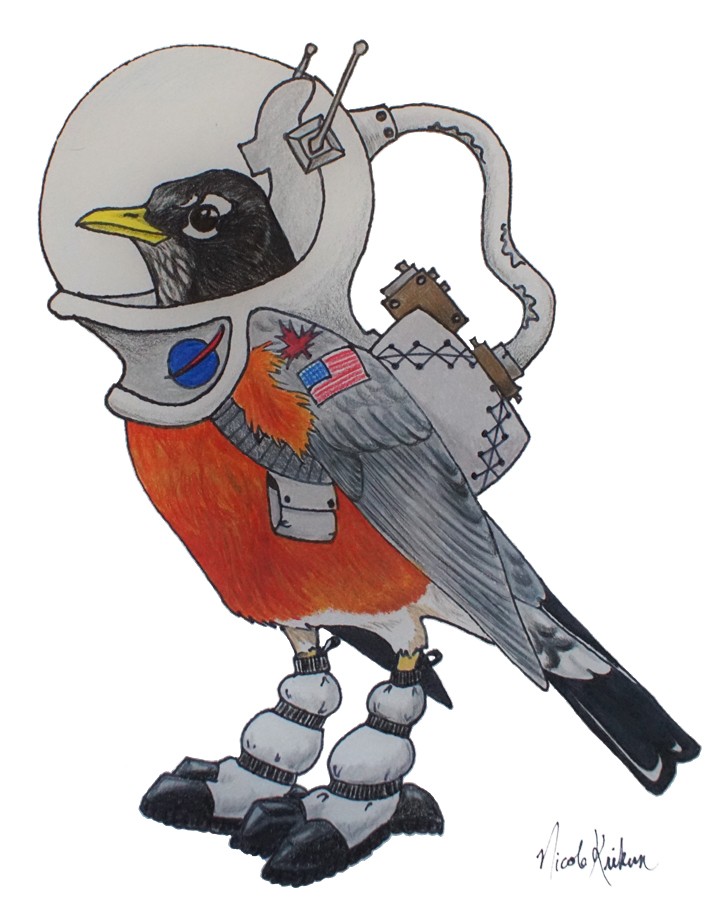
Space robin by Nicole Krikun.